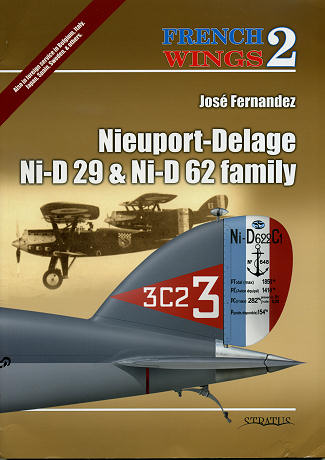 It is always a
delight to receive a book on a subject that you thought would never be done. Yet
the fine folks at Stratus publishing have managed to put together a book that I
think is really superb on an interesting subject, the French
Nieuport-Delage 29 and 62 family of aircraft.
It is always a
delight to receive a book on a subject that you thought would never be done. Yet
the fine folks at Stratus publishing have managed to put together a book that I
think is really superb on an interesting subject, the French
Nieuport-Delage 29 and 62 family of aircraft.
If you've not had the chance to read a Stratus book,
then you are in for a treat. Not only are they well written, but they are chock
full of photographs and color profiles based on those photographs. This one is
no exception with dozens upon dozens of well chosen image and great profiles.
We are provided with a full history of the two planes
covered in the book from the post WWI Ni-D 29 series to the later Ni-D 62, which
saw quite a bit of combat in the Spanish Civil war. The Ni-D 29 came from the
need to have something better than what the French ended WWI flying. There was
also a need to concentrate on just one aircraft in the more austere post war
period. The Ni-D 29 offered enough of an improvement over others to be the one
chosen. It was somewhat unique in that the fuselage was molded plywood, giving
it a sleek aerodynamic advantage. This trait was also used on the later Ni-D 62
family.
The Ni-D 29 was quite a successful plane not only with
the French, but with the Japanese, Belgians, Italians and some others. Thanks to
the success of the Ni-D 29, Nieuport-Delage was able to provide the next
successful fighter design to take the French air force into the 1930s. This time
it was a sesquiplane design that was chosen. This was partly due to the extreme
flex of the long wing struts when the design was originated as a parasol
fighter. Again, a wood shell fuselage, though a series was built with all
aluminum coating. Again, this was a relative success in export, and thanks to it
being available and being built by the Spanish, it was a major player in the
early years of the Spanish Civil War. Though obsolescent around that time, it
did provide what was needed when it was needed. Even with the French air force
the plane was still being used as an advanced trainer when WWII started and some
lasted until mid-war in that role.
In addition to a history of the types, there is a
section on the various camouflage and markings schemes worn by these planes.
None of these aircraft survived, but thanks to Stratus, we now have a fine
reference book in English on these important French aircraft. Like all of
Stratus' books, this one is a keeper and a must have by those interested in WWII
French aviation.
June 2011
Review book courtesy of
MMP
Books,
where you can order your copy of this and many other superb aviation and
modeling books. The book is also available through Casemate Publishing in the US
and Platypus Publications in Australia.
If you would like your product reviewed fairly and quickly, please
contact
me or see other details in the Note to
Contributors.
 It is always a
delight to receive a book on a subject that you thought would never be done. Yet
the fine folks at Stratus publishing have managed to put together a book that I
think is really superb on an interesting subject, the French
Nieuport-Delage 29 and 62 family of aircraft.
It is always a
delight to receive a book on a subject that you thought would never be done. Yet
the fine folks at Stratus publishing have managed to put together a book that I
think is really superb on an interesting subject, the French
Nieuport-Delage 29 and 62 family of aircraft.